Гоночный мотоцикл CAGIVA Mito Lawson
Для чего существует закон? Для того, чтобы его изящно объехать. Именно такое ощущение рождается, когда смотришь на историю долгой и безуспешной борьбы законодателей с мотоциклистами. С одной стороны, солидные члены всяческих парламентских комиссий и подкомиссий, убежденные, что мотоцикл — эту «машину самоубийц» — надо сделать тихоходнее пешехода. С другой — разношерстная публика, искренне убежденная, что каждый имеет право распоряжаться своей головой по собственному усмотрению. Посередке — мотоциклетные фирмы, вынужденные дать покупателям именно то, что они хотят.
Итальянские законодатели приняли ограничение: получить права в 16 лет — пожалуйста, но вот мотоциклом можно управлять лишь 125-кубовым. То есть подростки самого «мотоциклетного» возраста — с 16 до 18 лет — были обречены красоваться перед своими подругами лишь на хиленьких мотоциклеточках, на которых и «сотню»-то не выжмешь. Южный темперамент и явно выраженный спрос сделали свое дело: с современной итальянской «осьмушкой» не советую связываться водителю «Явы». Да что там «Ява» — с ней бесполезно бороться и водителю «Жигулей»!
Под стать динамике и внешность — уверен, с первого взгляда на эту фотографию вы никак не подумаете, что речь у нас пойдет о машине столь малого класса. От старших собратьев этот мотоцикл можно отличить скорее не внешне, а на слух: шмелиную песню «раскрученного» двухтактника все же не сравнить с рыком четырехтактного двигателя.
Итальянский концерн «Каджива» — один из наиболее мощных и динамичных в европейской мотопромышленности, а «Каджива Мито» — любимец молодежи не только в Италии. Ярко-алые мотоциклы завоевали авторитет в шоссейно-кольцевых гонках «королевского» класса 500 см 3 . В июле 1992 года Эдди Лоусон принес фирме долгожданную победу на этапе чемпионата мира. «Сегодня побеждай, завтра продавай» — на этом давно уже держится маркетинговая стратегия многих фирм. Не дала пропасть плодам успеха и «Каджива» — в названии нового мотоцикла заиграл отблеск победы: «Каджива Мито Лоусон».
Одноцилиндровый двухтактный двигатель этого мотоцикла способен развивать прямо-таки умопомрачительную для класса 125 см 3 мощность: 33,5 л. с. при 10 500 об/мин. Карбюратор «Делл Орто» с диаметром диффузора 28 мм по своей конструкции весьма сходен с теми, которые применяются на чистокровных гоночных мотоциклах. На впуске установлены лепестковые клапаны, на выпуске — специальный клапан с электронным управлением. Охлаждение — жидкостное, система смазки — раздельная. Хотя лучше всего этот двигатель проявляет себя в диапазоне от 9000 до 10 500 об/мин, он уверенно «подхватывает» уже с 4000 об/мин. А выбрать свой режим на любой скорости движения поможет семиступенчатая коробка передач.
Не только двигатель роднит этот мотоцикл с чистокровными гоночными машинами. Ходовая часть — тоже явно гоночного происхождения. Основу рамы образуют два элемента из алюминиевого сплава, идущие по диагонали от рулевой колонки к узлу задней подвески. Передняя телескопическая вилка имеет ход 123 мм. Задняя подвеска системы «Софт-дамп» с одним центральным амортизатором и рычажным механизмом, обеспечивающим прогрессивную характеристику. Ход заднего колеса 133,5 мм. Трехспицевые колеса, отлитые из легкого сплава, обуты в бескамерные радиальные шины «Мишлен». Дисковые тормоза «Брембо» (диаметр диска 230 мм) установлены и спереди, и сзади.
Журналисты, которым довелось испытать этот мотоцикл, отмечают не только превосходные качества двигателя. Больше всего им понравилась изумительная управляемость мотоцикла. «В любых условиях мотоцикл идет точно туда, куда вы его направляете» — поверьте, это можно сказать не о всякой двухколесной машине.
При этом мотоцикл, опровергая старое представление о том, что спортивность несовместима с комфортом, очень удобен даже в дальних поездках. Хорошо защищающий от непогоды обтекатель, электростартер, две фары мощностью по 25 Вт. Единственное неудобство в далеких путешествиях — необходимость часто останавливаться для дозаправки, несмотря на 18-литровый бензобак. Но повышенный аппетит — слабое место всех «крученых» стодвадцатипяток. Аппетит и цена — в Италии он стоит 6 400 000 лир — почти вдвое больше 350-кубовой «Явы».
Alfa Romeo MiTo
Обновленная Alfa Romeo MiTo предстала перед широкой публикой на международном осеннем франкфуртском автосалоне в 2013 году. Стоит отметить, что модель является первым плановым рестайлингом первого поколения, дебютировавшего пятью годами ранее. Производитель установил новую трансмиссию, освежил салон и немного подретушировал дизайн. Хоть и дореформенная модель выглядит довольно актуально, было принято решение унифицировать внешность со старшими моделями линейки. В оформлении передка заметно прибавилось хрома. В глаза бросаются округлые фары головного освещения с небольшими фокусирующими линзами и новой элегантной окантовкой. Решетка радиатора слегка сместилась вниз и поменяла свое оформление. Она обладает фирменной формой геральдического щита и прикрыта множеством горизонтально ориентированных ребер. Внизу, на переднем бампере, расположился крупный воздухозаборник. Он стал немного шире и получил новые блоки противотуманных фар. В общем и целом, модель получила ряд приятных косметических изменений, приятно освеживших ее образ.
Размеры
Альфа Ромео МиТо- это субкомпактный трехдверный хэтчбек премиум класса. Его габаритные размеры составляют: длина 4063 мм, ширина 1720 мм, высота 1446 мм, а колесная база- 2511 мм. Клиренс у модели небольшой- всего 140 миллиметра. Такая посадка характерна для большинства маленьких европейских автомобилей. Благодаря относительно низкому центру тяжести, они довольно неплохо держат дорогу и отличаются отличной маневренностью. С другой стороны, жесткая подвеска с малой энергоемкостью будет довольно требовательна к состоянию дорожного полотна. Стоит отметить, что хэтчбек построен на платформе Fiat Grande Punto, а значит у него распространенная, для этого класса, компоновка шасси. Спереди расположились независимые стойки McPherson со стабилизатором поперечной устойчивости, а сзади- полузависимая упругая балка.
Технические характеристики
На отечественном рынке, хэтчбек оснащается линейкой из трех моторов, механическими и роботизированными коробками передач, а также исключительно передним приводом. Благодаря широкому спектру силовых агрегатов, модель становится довольно универсальной и способна удовлетворить большинство запросов потенциального покупателя.
Базовым моторчиком Alfa Romeo MiTo является компактный двухцилиндровый рядный турбированный бензиновый агрегат всего на 875 кубических сантиметров. Несмотря на крошечный литраж, он развивает вполне серьезные 105 лошадиных сил и 120 Нм крутящего момента. Он стыкуется исключительно с шестиступенчатой механикой и разгоняет хэтчбек до ста километров в час за 11,4 секунды. Расход топлива ожидаемо маленький- всего 4,2 литра бензина на сто километров пути в комбинированном цикле движения. Для любителей погорячее, производитель может предложить довольно мощный, для такой маленькой машинки, двигатель. Это 1,4-литровая рядная бензиновая турбированная четверка. В зависимости от варианта исполнения, она выдает 140-170 лошадиных сил и около 230 Нм крутящего момента. Благодаря такому табуну под капотом, хэтчбек выстреливает до сотни за 7,3-8,1 секунды и максимально набирает 209-219 километров в час. Несмотря на отличную динамику, расход топлива вполне демократичный- около 5,4 литров на сотню в смешанном цикле.
Несмотря на свои размеры, МиТо отличается спортивным характером. У нее приятный неоклассический дизайн, который, как нельзя лучше, подчеркнет характер и индивидуальность своего владельца. Такой автомобиль не растворится в сером будничном потоке и не затеряется на большой парковке торгового центра. Салон- это царство добротных материалов отделки, спортивной эргономики и комфорта. Даже плотный трафик или заторы в час-пик не смогут доставить водителю лишних неудобств. Производитель прекрасно понимает, что душой и сердцем автомобилей такого рода является их двигатель. Именно поэтому, под капотом хэтчбека расположился компактный, но удивительно мощный силовой агрегат, являющийся сплавом современных разработок и многолетнего опыта итальянских инженеров. Alfa Romeo MiTo сочетает в себе практичность субкомпактного класса с характером спорткара.
Видео
Cagiva Mito II Lawson Replica
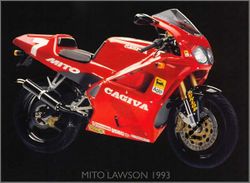 |
|
| Cagiva Mito II Lawson Replica | |
| Manufacturer | |
|---|---|
| Production | 1993 |
| Class | Sport Bike |
| Engine | |
| Bore / Stroke | 55.9mm x 55.9mm |
| Compression ratio | 13.0:1 |
| Horsepower | 32.99 HP (24.6 KW) @ 10500RPM |
| Torque | 14.01 ft/lbs (19.0 Nm) @ 9000RPM |
| Transmission | Gear box: 7-speed, manual
Clutch: wet multi-disc, manual |
| Suspension | Front: upside-down telescopic fork Rear: adjustable mono-shock |
| Brakes | Front: single 320mm disc, 4-piston caliper Rear: single 230mm disc, 1-piston caliper |
| Front Tire | 110/70-17 |
| Rear Tire | 150/70-17 |
| Weight | 117.0 kg (wet) |
| Manuals | Service Manual |
The Cagiva Mito II Lawson Replica was a liquid-cooled, two-stroke, single cylinder Sport Bike motorcycle produced by Cagiva in 1993. Max torque was 14.01 ft/lbs (19.0 Nm) @ 9000 RPM. Claimed horsepower was 32.99 HP (24.6 KW) @ 10500 RPM.
Contents
Engine [ edit ]
A 55.9mm bore x 55.9mm stroke result in a displacement of just 124.0 cubic centimeters.
Drive [ edit ]
The bike has a 7-speed, manual transmission. Power was moderated via the wet multi-disc, manual.
Chassis [ edit ]
It came with a 110/70-17 front tire and a 150/70-17 rear tire. Stopping was achieved via single 320mm disc, 4-piston caliper in the front and a single 230mm disc, 1-piston caliper in the rear. The front suspension was a upside-down telescopic fork while the rear was equipped with a adjustable mono-shock.
1993 Cagiva Mito II Lawson Replica [ edit ]
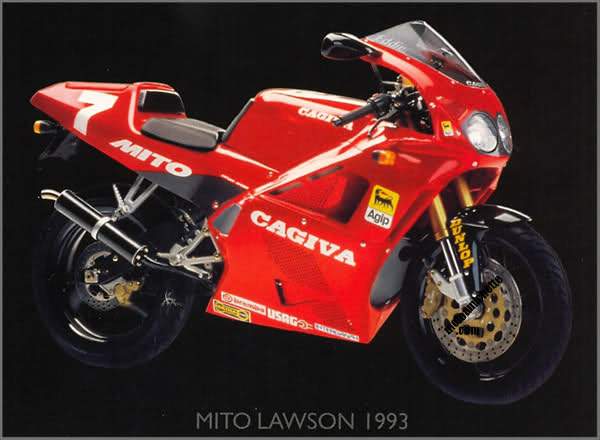
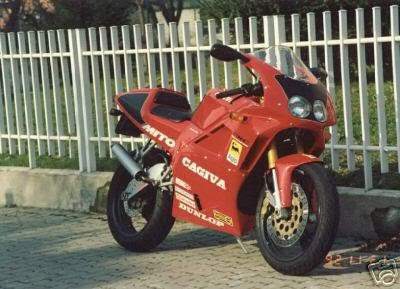

The 1993 MY Cagiva Mito II Lawson Replica mainly addresses racing fans that want their machine to look like the official two-wheeler Cagiva uses in official races. It has, at its heart, a liquid-cooled, four-stroke, 124cc, single cylinder powerplant mated to a seven-speed manual transmission and can produce a claimed 33 horsepower and 19 Nm of torque.
This machine has the same innards and features as the base Mito II, but its bodywork has been painted with a special, Racing Red paint scheme and has been accessorized with sponsor decals, that make it stand out in a crowd.
Мотоцикл Mito II Lawson Replica (1994): технические характеристики, фото, видео
Cagiva Mito 125 II Koncinski Replica
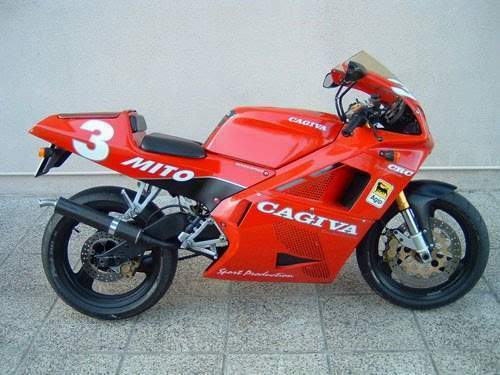
Make Model
Cagiva Mito 125 II Koncinski Replica
Year
Engine
Capacity
Induction
Ignition
Max Power
Max Torque
Transmission
Front Suspension
Rear Suspension
Front Brakes
Rear Brakes
Front Tyre
Rear Tyre
Dry Weight
Fuel Capacity
Braking 60 – 0 / 100 – 0
Standing ј Mile
Top Speed
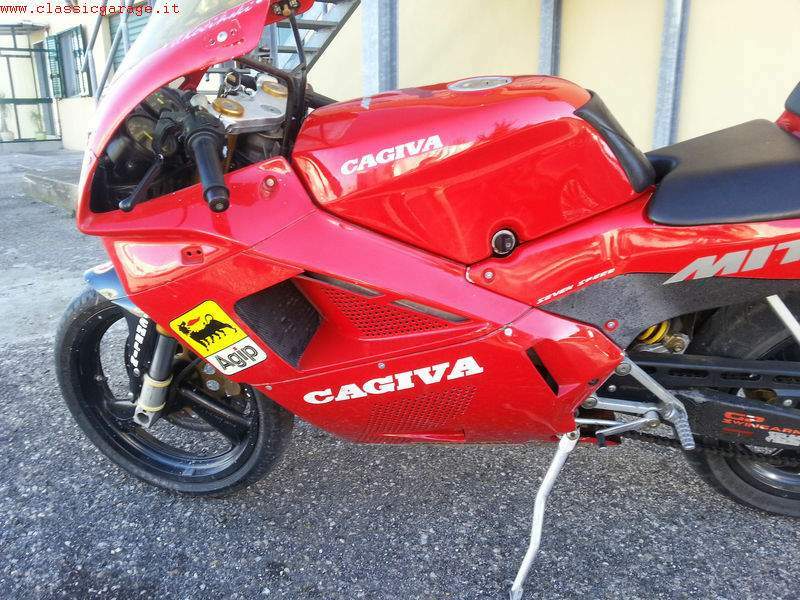
1994 John Koncinski Myth II Replica
Tags: Replica Kocinski staining characterized by the number 3 on the tail and to celebrate the third place finish in the 1994 season by American rider in the 500 class. The Kocinski replication is identical in all respects to Eddie Lawson II.
Aprilia RS125R Extrema vs Cagiva Mito Race
IF YOU crave the quiet life, don’t even think about an Aprilia RS125R Extrema. The easy sophistication of modern motorcycling is definitely not on the agenda here. Neither are workaday concepts such as ‘trickling through town unnoticed’, ‘just riding round a bit’ and ‘being remotely sensible’.
No. The 34bhp Extrema is for committed nutters; fans of head-down, full-bore lOOmph momentumism. The Extrema is for those willing to coax unreal speed from puny power, then preserve it at all costs. The Extrema responds only when subjected to the uncompromising attack plan of a 125 grand prix racer: 1) peg throttle open 2) tread gear lever furiously 3) cling to speed like demented pitbull, and never let go. Dogged slipstream-ing, precision overtaking and ferocious corner speeds are the 125 racer’s trademarks; buy an Extrema and they will become yours too, reality suspended forthwith.
It’s all knees in, blue smoke and black visor. Ideally there’s some Italian blood in the family tree. Move only when necessary and in measured amounts. Brake later, much later, and then brake less. Abuse the engine, caress the chassis or go in slow arid come out crawling. Rev it ruthlessly, all the time. Buy exotic two-stroke oils, never hesitate, relax or be embarrassed. Be in fact a short grand prix hero, and 50 times a day peek in the mirrors to check a policeman didn’t witness what you just did.
This is life on the Extrema – outrageous fun, hopeless transport. To a real grand prix racer it’s probably a slug, his humble paddock hack most likely, but just as the fastest GP bikes now come often as not from Italy, so indisputably “do the most authentic GP replicas. And if ever a road-going motorcycle were fit to receive a celebrated factory bottom, this is the one. Really, to use the Extrema as a plain motorbike is to ask the impossible.
Its heavenly curves and racy detail elevate it high above the 125 norm; a sprung front brake master cylinder, itself a mere thimble; myriad dinky button screws; and a total absence of cable guides and clutter score a desirability rating at least on a par with the RGV250. Big bike snobs may scoff, but in this unrestricted guise the Extrema (like the Cagiva Mito) is genuinely classless; no more a novice-friendly stepping stone than a Honda GoldWing. Gone are the days when having the 125 .business meant knocking out the restrictor and binning the L-plates. Graduated learners should ride a middleweight first – work up to the Extrema.
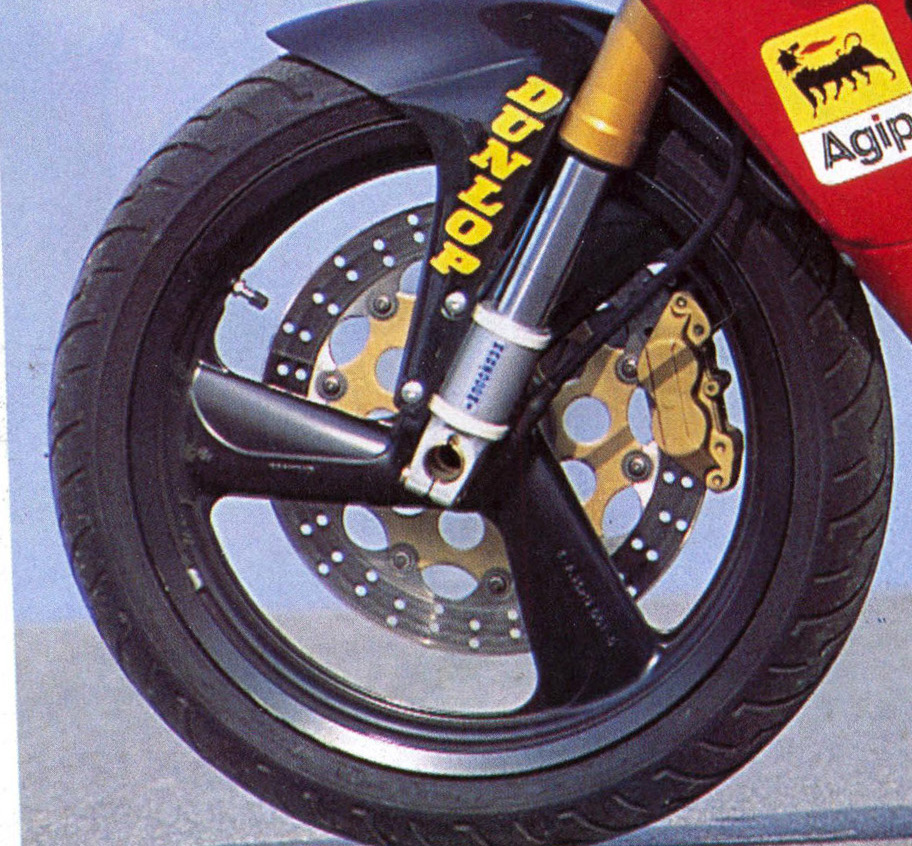
After all, it costs Ј3650, so should deliver like any other performance bike. There’s plenty of bluffing (carbon fibre stickers etc) but you can’t foist tat onto the huge and discerning Italian 125 market. An ally twin-spar frame, 40mm upside-down forks, a four-piston caliper, 320mm floating disc, and wide, 17in Dunlop radials are just for starters.
The grand prix derived touches are endless. By Japanese standards its fasteners and fittings are sparse and tiny; the opposed-piston rear caliper renders most efforts plain clumsy. The sprung to unsprung weight ratio takes on extra significance on a bike weighing just 115kg dry and the Extrema gives its suspension every chance by using scooped-spoke wheels unusually delicate by production bike standards^ The forks share one spring (left leg) and one damper unit (right leg) to counterbalance the front disc and caliper, and minimise steering inertia. And the Extrema is also serious about aerodynamics, the fairings have no sharp edges, only unexpected curves, while the underseat area is faired off to smooth the air flow around the rear wheel. Tucking in can send a labouring tacho needle singing into the red.
This, the RS125R version of the Extrema, is ostensibly an RS125, the short wheelbase beauty that succeeded the AF1 Sport Pro at the top of Aprilia UK’s range, plus a carbon fibre exhaust can (wrapped round thin-walled ally), carbon fibre air ducts, and a polished metal finish on that dribblingly beautiful frame and swing-arm. It’s an incredible piece of metal, neatly welded aluminium alloy spars cast into ribbed C-sections that are both light (9.75kg according to the frame sticker) and stiff beyond a 125’s wildest performance dreams. The curva-ceously braced swing-arm, which replaced the old AF1-style mono-arm, is equally awesome and allows the Extrema to run a drastically short 1345mm wheel-base without a hint of instability. And that’s the crux of the bike’s handling. It doesn’t steer with the nervous intensity of the Mito, but clings to the race-ready Cagiva by dint of its infallible precision.
It has, for a 125, big handling: lightness of touch but also a planted footprint which makes it less out and out fun than the Mito, but less of a toy too. The flattop tank, slotted and waisted for knees provides bracing without putting destabilising pressure on the wide bars, even under bonkers braking. The stubby pegs are high and rearset and make six footers as welcome as traditional 125 midgets. A full tuck is amazingly comfortable, in fact the whole chassis is a brilliant blend of lunacy, response, balance and security. Tracking the Mito at the Pembrey race track in Wales, I felt I could flick faster, and more accurately than Nige Breslain (easily the best Subbuteo player in my school).
Truth is, I couldn’t. Returning from the medical centre I surmised that the steeply profiled Dunlops lend much needed zip to the steering, but their hard wearing compound dumped me out. The suspension, too, could use some damping adjustment as, on rougher surfaces, the rear shock got choppy and the forks, progressive enough on the immense but abrupt brakes, bounced back at the crucial turn in point. The Cagiva, meanwhile, was still thrashing round. Swallowing ZXRs whole.
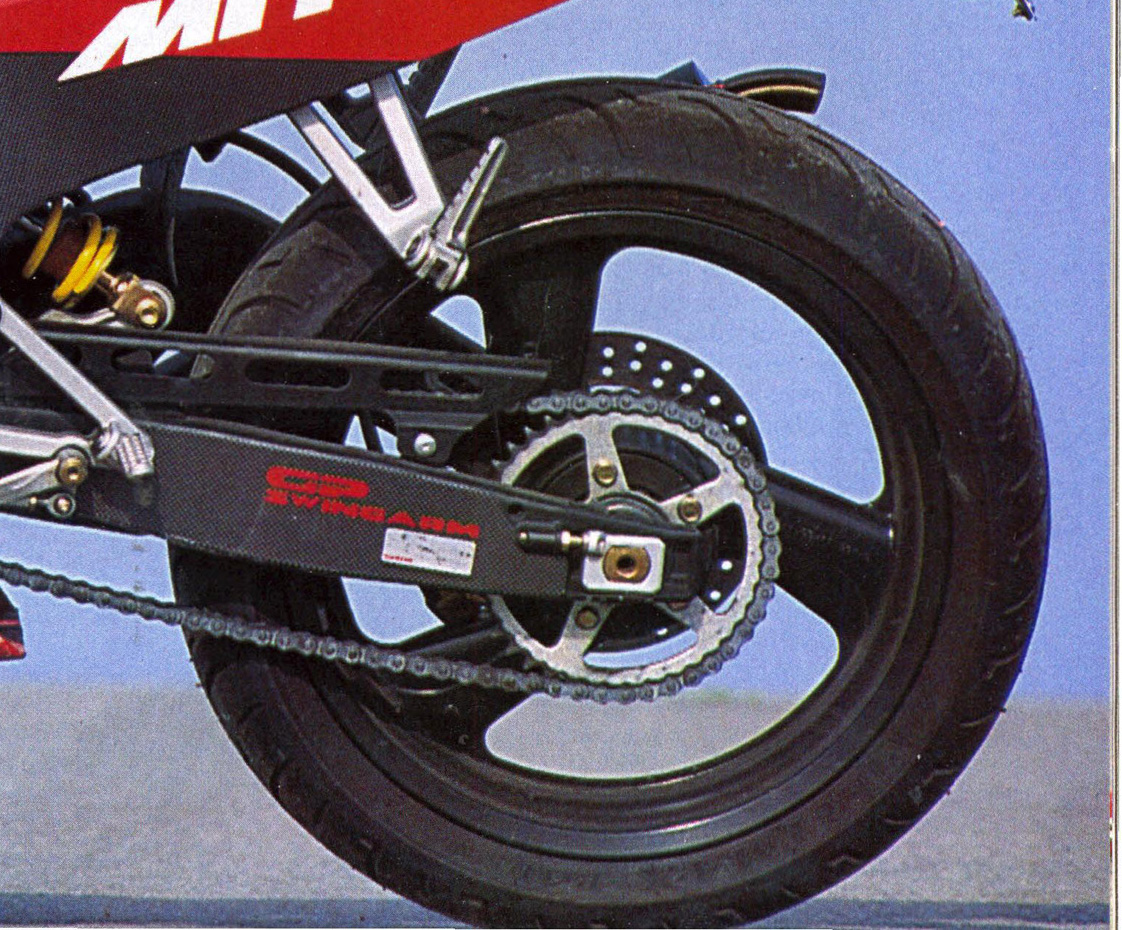
The engine, unchanged from the AF1 series apart from unspecified port work, is just motion for the chassis. On paper it’s all there — a compact liquid-cooled single, long life Nikasil plated barrels, RAVE exhaust valve and a lumpy 14.5:1 compression ratio – but is dwarfed by the handling. It sounds and revs like a 12bhp TZR125, vibrates despite a balance shaft, was stuffed out of sight by the Mito.
Moving from the free-revving (but fickle) Cagiva to the woolly Extrema was like losing a cylinder on a KR-1S twin, the crisp snap that makes all good two-strokes worth thrashing sadly absent. What the Extrema has though is proven reliability — use a good oil and it’ll need re-ringing less often than a ZXR will need shimming. And what it does is click straight into life on the button (no kick-start), warm quickly and pull keenly enough from 6500rpm. As the two-stage RAVE shifts at 8100rpm, the hitherto •sterile exhaust note finally cuts an edge and the revs whizz up to the 11,000 before tailing off fast. In a lesser chassis that would be exciting, in the Extrema it’s just enough.
Anyway, these 125 stand or fall on their gearboxes. The Extrema’s uses the same internals as the Sport Pro which means three clonky lower gears and three sweet upper ones, spaced close enough for a shift at peak power at ll.000rpm to drop the needle at the top of the torque curve at 9000rpm. So despite a late and jerky clutch it’s easy enough to keep the Extrema buzzing either in the useful 6-8000 range or up at boiling point. Our tester could reach 80 indicated mph anytime, though often only after dropping to fifth, and given a long enough stretch exploited its tall overall gearing to overhaul the Mito.
Who buys Extremas? According to Aprilia UK a typical customer is still to emerge even after selling 300 bikes since last August. “We’ve had plenty of younger blokes, as you’d expect,” says Aprilia’s Steve Reynolds, “but just as many older customers, including a 53-year-old farmer. I think the public now know what Aprilias are, a lot of credit has to go to the company’s GP success.” The RS/R version comes in at the same, price as the plain RS, maintaining Italy’s relative advantage over the Japanese yen (TZR125: Ј3939). A free Abus goes to every Aprilia customer.
In spite of its intoxicating imagery and the obvious legal advantages of playing racers on a 125 in preference to a FireBlade, the Extrema still gets a tad tiresome when there are miles to be done or metropoli to be crossed. Presumably, all these mature customers have another bike for distance days, when 75 miles between petrol stops simply isn’t enough.
The clearest advantage the Extrema has over the Mito is that, by comparison, it is positively staid. You can say no to its traffic light pleas for ll,000rpm and a screaming clutch. You can gurgle passed a policemen looking every inch the responsible motorcyclist. Then, when the going’s good and that bout of sobriety evaporates, you can just pin it.
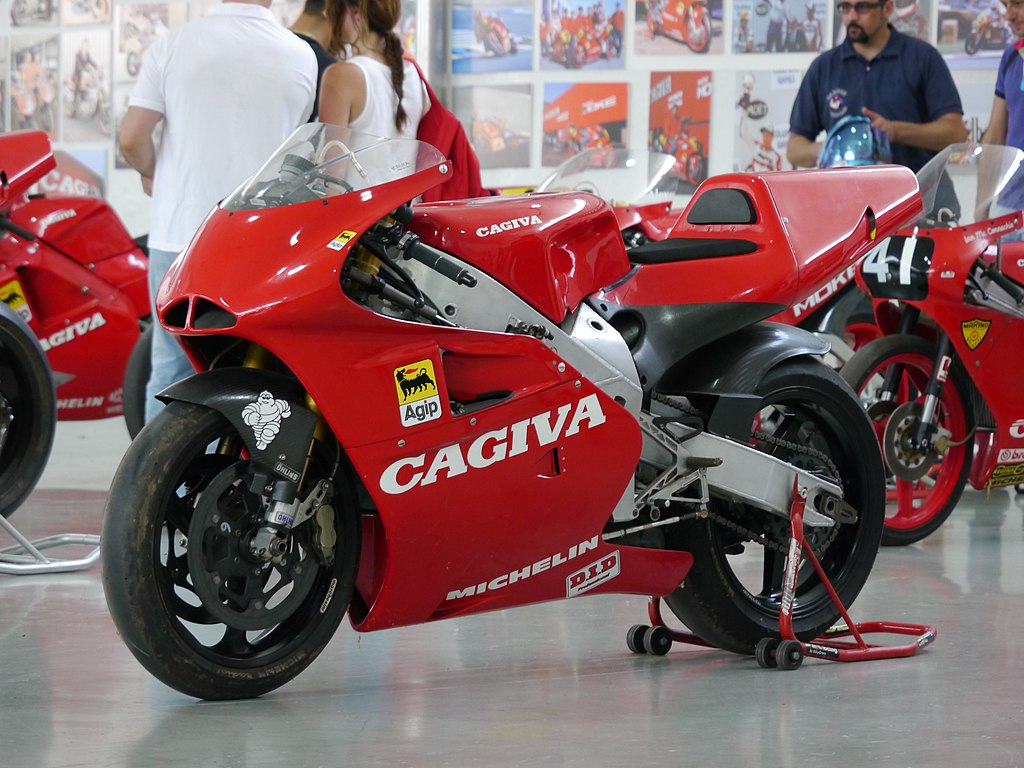
Cagiva Mito Race
RIDING CAGIVA’S works racer Mito is more fun than having a fag behind the school bike shed. It’s the same sort of nerve-tingling, adrenalin-pumping thrill, but believe me, it feels far, far naughtier. Breathing in lungfuls of racing two-stroke oil is one of the great joys of life.
It’s all about tunnel-vision excitement. Without mirrors you just don’t know when Plod is creeping up, but somehow you simply don’t care. Just keep your head down, screw that throttle open and hope for the best. Familiar?
With a claimed top speed of 120mph, this must be the fastest 125 on the block. However you look at it, the Race version of the standard Lawson II Mito is about the nearest thing you’ll find on the road to a fully-blown grand prix maahine, Extrema included and it’s not just the Eddie tag that gives it street cred. Those tasty looks, that smooth feel and the crackling sound are pedigree, while some red-hot performance will see this Mito burn off anything else in its class.
On the road it’s a bit of a disaster. The lightweight moped chain stretches like a lakky band and the jetting is so crucial that the engine can become bogged down in cold, damp conditions. Not to mention the lack of mirrors and starter motor, although the bike push-starts with ease. Just don’t stall at the lights, which is easier said than done, because there’s no idle either.
Still, this Italian Cagiva race series-spec bike flew down from Peterborough to London on a still, warm day, easily reaching an indicated 180kph (112mph) and holding seventh gear with ease.
Round town it’s nifty, but the tall first gear means you have to rev like mad to get a clean drag from the lights.
The ride back was altogether different — and plain hard work. The roads were damp and the heavy night air played havoc with the jetting. Carb set-up is so crucial that the bike comes with a workshop manual to enable you to jet up according to the weather and at the time I’d have preferred the less fussy Extrema. Petrol consumption plummeted from 42mpg on the southbound trip to just over 35mpg, hitting reserve after just 76 miles. And I had to fight to maintain 85mph, hardly ever getting into top.
The race circuit is the Mito’s true home, and at Pembrey it made a mockery of the poor old Aprilia Extrema (which it should have done), along with a host of other, much bigger bikes.
The razor-sharp, almost nervous steering and the crisp power would even turn Mr Nice-But-Dim into a sadistic, fire-breathing demon. This Mito, which is both raced in Ministock and ridden on the road by importers Three Cross, is one of a limited bunch of specials built each year by the factory. The engine has been extensively breathed on and the suspension uprated, while some excess flab has been trimmed off. Race-spec wheels and tyres complete the package.
It has a useful midrange for a 125, but the motor screams to be thrashed and the race ignition allows it to rev freely to the 13,000rpm limit. That’s great, because otherwise you’d have to concentrate on the wafer-thin powerband between 9500rpm and the ll,000rpm red line to stay alight. Slip below that and you need to nip down a couple of cogs to build the revs up again.
The Mito packs a punch like no other 125 coming out of corners and despite my extra weight and size, I was able to pull away from tiny Tim Thompson riding the Aprilia.
Handling is the other great Mito joy. Steering is so quick it’s almost twitchy, but the bike is smooth and steady through even bumpy bends, thanks to the fully-adjustable race suspension.
The improved midrange, lack of weight, stonking brakes and excellent handling makes the Cagiva the perfect wet-weather racer. You can get away with whacking on the power earlier than you’d ever dare on a big bike. Race-compound Hi-Sport radials tyres also made a huge difference, biting hard while Tim slid around in the damp.
If I had a spannerman who understood barometric pressure, a luxurious motorhome and a Kocinski surly Southern drawl, I’d love to race this little beauty. But own it as a road bike? Gimme a fag any day.
Мотоцикл Mito II Lawson Replica (1994): технические характеристики, фото, видео
Cagiva Mito 125 II Koncinski Replica

Make Model
Cagiva Mito 125 II Koncinski Replica
Year
Engine
Capacity
Induction
Ignition
Max Power
Max Torque
Transmission
Front Suspension
Rear Suspension
Front Brakes
Rear Brakes
Front Tyre
Rear Tyre
Dry Weight
Fuel Capacity
Braking 60 – 0 / 100 – 0
Standing ј Mile
Top Speed

1994 John Koncinski Myth II Replica
Tags: Replica Kocinski staining characterized by the number 3 on the tail and to celebrate the third place finish in the 1994 season by American rider in the 500 class. The Kocinski replication is identical in all respects to Eddie Lawson II.
Aprilia RS125R Extrema vs Cagiva Mito Race
IF YOU crave the quiet life, don’t even think about an Aprilia RS125R Extrema. The easy sophistication of modern motorcycling is definitely not on the agenda here. Neither are workaday concepts such as ‘trickling through town unnoticed’, ‘just riding round a bit’ and ‘being remotely sensible’.
No. The 34bhp Extrema is for committed nutters; fans of head-down, full-bore lOOmph momentumism. The Extrema is for those willing to coax unreal speed from puny power, then preserve it at all costs. The Extrema responds only when subjected to the uncompromising attack plan of a 125 grand prix racer: 1) peg throttle open 2) tread gear lever furiously 3) cling to speed like demented pitbull, and never let go. Dogged slipstream-ing, precision overtaking and ferocious corner speeds are the 125 racer’s trademarks; buy an Extrema and they will become yours too, reality suspended forthwith.
It’s all knees in, blue smoke and black visor. Ideally there’s some Italian blood in the family tree. Move only when necessary and in measured amounts. Brake later, much later, and then brake less. Abuse the engine, caress the chassis or go in slow arid come out crawling. Rev it ruthlessly, all the time. Buy exotic two-stroke oils, never hesitate, relax or be embarrassed. Be in fact a short grand prix hero, and 50 times a day peek in the mirrors to check a policeman didn’t witness what you just did.
This is life on the Extrema – outrageous fun, hopeless transport. To a real grand prix racer it’s probably a slug, his humble paddock hack most likely, but just as the fastest GP bikes now come often as not from Italy, so indisputably “do the most authentic GP replicas. And if ever a road-going motorcycle were fit to receive a celebrated factory bottom, this is the one. Really, to use the Extrema as a plain motorbike is to ask the impossible.
Its heavenly curves and racy detail elevate it high above the 125 norm; a sprung front brake master cylinder, itself a mere thimble; myriad dinky button screws; and a total absence of cable guides and clutter score a desirability rating at least on a par with the RGV250. Big bike snobs may scoff, but in this unrestricted guise the Extrema (like the Cagiva Mito) is genuinely classless; no more a novice-friendly stepping stone than a Honda GoldWing. Gone are the days when having the 125 .business meant knocking out the restrictor and binning the L-plates. Graduated learners should ride a middleweight first – work up to the Extrema.

After all, it costs Ј3650, so should deliver like any other performance bike. There’s plenty of bluffing (carbon fibre stickers etc) but you can’t foist tat onto the huge and discerning Italian 125 market. An ally twin-spar frame, 40mm upside-down forks, a four-piston caliper, 320mm floating disc, and wide, 17in Dunlop radials are just for starters.
The grand prix derived touches are endless. By Japanese standards its fasteners and fittings are sparse and tiny; the opposed-piston rear caliper renders most efforts plain clumsy. The sprung to unsprung weight ratio takes on extra significance on a bike weighing just 115kg dry and the Extrema gives its suspension every chance by using scooped-spoke wheels unusually delicate by production bike standards^ The forks share one spring (left leg) and one damper unit (right leg) to counterbalance the front disc and caliper, and minimise steering inertia. And the Extrema is also serious about aerodynamics, the fairings have no sharp edges, only unexpected curves, while the underseat area is faired off to smooth the air flow around the rear wheel. Tucking in can send a labouring tacho needle singing into the red.
This, the RS125R version of the Extrema, is ostensibly an RS125, the short wheelbase beauty that succeeded the AF1 Sport Pro at the top of Aprilia UK’s range, plus a carbon fibre exhaust can (wrapped round thin-walled ally), carbon fibre air ducts, and a polished metal finish on that dribblingly beautiful frame and swing-arm. It’s an incredible piece of metal, neatly welded aluminium alloy spars cast into ribbed C-sections that are both light (9.75kg according to the frame sticker) and stiff beyond a 125’s wildest performance dreams. The curva-ceously braced swing-arm, which replaced the old AF1-style mono-arm, is equally awesome and allows the Extrema to run a drastically short 1345mm wheel-base without a hint of instability. And that’s the crux of the bike’s handling. It doesn’t steer with the nervous intensity of the Mito, but clings to the race-ready Cagiva by dint of its infallible precision.
It has, for a 125, big handling: lightness of touch but also a planted footprint which makes it less out and out fun than the Mito, but less of a toy too. The flattop tank, slotted and waisted for knees provides bracing without putting destabilising pressure on the wide bars, even under bonkers braking. The stubby pegs are high and rearset and make six footers as welcome as traditional 125 midgets. A full tuck is amazingly comfortable, in fact the whole chassis is a brilliant blend of lunacy, response, balance and security. Tracking the Mito at the Pembrey race track in Wales, I felt I could flick faster, and more accurately than Nige Breslain (easily the best Subbuteo player in my school).
Truth is, I couldn’t. Returning from the medical centre I surmised that the steeply profiled Dunlops lend much needed zip to the steering, but their hard wearing compound dumped me out. The suspension, too, could use some damping adjustment as, on rougher surfaces, the rear shock got choppy and the forks, progressive enough on the immense but abrupt brakes, bounced back at the crucial turn in point. The Cagiva, meanwhile, was still thrashing round. Swallowing ZXRs whole.

The engine, unchanged from the AF1 series apart from unspecified port work, is just motion for the chassis. On paper it’s all there — a compact liquid-cooled single, long life Nikasil plated barrels, RAVE exhaust valve and a lumpy 14.5:1 compression ratio – but is dwarfed by the handling. It sounds and revs like a 12bhp TZR125, vibrates despite a balance shaft, was stuffed out of sight by the Mito.
Moving from the free-revving (but fickle) Cagiva to the woolly Extrema was like losing a cylinder on a KR-1S twin, the crisp snap that makes all good two-strokes worth thrashing sadly absent. What the Extrema has though is proven reliability — use a good oil and it’ll need re-ringing less often than a ZXR will need shimming. And what it does is click straight into life on the button (no kick-start), warm quickly and pull keenly enough from 6500rpm. As the two-stage RAVE shifts at 8100rpm, the hitherto •sterile exhaust note finally cuts an edge and the revs whizz up to the 11,000 before tailing off fast. In a lesser chassis that would be exciting, in the Extrema it’s just enough.
Anyway, these 125 stand or fall on their gearboxes. The Extrema’s uses the same internals as the Sport Pro which means three clonky lower gears and three sweet upper ones, spaced close enough for a shift at peak power at ll.000rpm to drop the needle at the top of the torque curve at 9000rpm. So despite a late and jerky clutch it’s easy enough to keep the Extrema buzzing either in the useful 6-8000 range or up at boiling point. Our tester could reach 80 indicated mph anytime, though often only after dropping to fifth, and given a long enough stretch exploited its tall overall gearing to overhaul the Mito.
Who buys Extremas? According to Aprilia UK a typical customer is still to emerge even after selling 300 bikes since last August. “We’ve had plenty of younger blokes, as you’d expect,” says Aprilia’s Steve Reynolds, “but just as many older customers, including a 53-year-old farmer. I think the public now know what Aprilias are, a lot of credit has to go to the company’s GP success.” The RS/R version comes in at the same, price as the plain RS, maintaining Italy’s relative advantage over the Japanese yen (TZR125: Ј3939). A free Abus goes to every Aprilia customer.
In spite of its intoxicating imagery and the obvious legal advantages of playing racers on a 125 in preference to a FireBlade, the Extrema still gets a tad tiresome when there are miles to be done or metropoli to be crossed. Presumably, all these mature customers have another bike for distance days, when 75 miles between petrol stops simply isn’t enough.
The clearest advantage the Extrema has over the Mito is that, by comparison, it is positively staid. You can say no to its traffic light pleas for ll,000rpm and a screaming clutch. You can gurgle passed a policemen looking every inch the responsible motorcyclist. Then, when the going’s good and that bout of sobriety evaporates, you can just pin it.

Cagiva Mito Race
RIDING CAGIVA’S works racer Mito is more fun than having a fag behind the school bike shed. It’s the same sort of nerve-tingling, adrenalin-pumping thrill, but believe me, it feels far, far naughtier. Breathing in lungfuls of racing two-stroke oil is one of the great joys of life.
It’s all about tunnel-vision excitement. Without mirrors you just don’t know when Plod is creeping up, but somehow you simply don’t care. Just keep your head down, screw that throttle open and hope for the best. Familiar?
With a claimed top speed of 120mph, this must be the fastest 125 on the block. However you look at it, the Race version of the standard Lawson II Mito is about the nearest thing you’ll find on the road to a fully-blown grand prix maahine, Extrema included and it’s not just the Eddie tag that gives it street cred. Those tasty looks, that smooth feel and the crackling sound are pedigree, while some red-hot performance will see this Mito burn off anything else in its class.
On the road it’s a bit of a disaster. The lightweight moped chain stretches like a lakky band and the jetting is so crucial that the engine can become bogged down in cold, damp conditions. Not to mention the lack of mirrors and starter motor, although the bike push-starts with ease. Just don’t stall at the lights, which is easier said than done, because there’s no idle either.
Still, this Italian Cagiva race series-spec bike flew down from Peterborough to London on a still, warm day, easily reaching an indicated 180kph (112mph) and holding seventh gear with ease.
Round town it’s nifty, but the tall first gear means you have to rev like mad to get a clean drag from the lights.
The ride back was altogether different — and plain hard work. The roads were damp and the heavy night air played havoc with the jetting. Carb set-up is so crucial that the bike comes with a workshop manual to enable you to jet up according to the weather and at the time I’d have preferred the less fussy Extrema. Petrol consumption plummeted from 42mpg on the southbound trip to just over 35mpg, hitting reserve after just 76 miles. And I had to fight to maintain 85mph, hardly ever getting into top.
The race circuit is the Mito’s true home, and at Pembrey it made a mockery of the poor old Aprilia Extrema (which it should have done), along with a host of other, much bigger bikes.
The razor-sharp, almost nervous steering and the crisp power would even turn Mr Nice-But-Dim into a sadistic, fire-breathing demon. This Mito, which is both raced in Ministock and ridden on the road by importers Three Cross, is one of a limited bunch of specials built each year by the factory. The engine has been extensively breathed on and the suspension uprated, while some excess flab has been trimmed off. Race-spec wheels and tyres complete the package.
It has a useful midrange for a 125, but the motor screams to be thrashed and the race ignition allows it to rev freely to the 13,000rpm limit. That’s great, because otherwise you’d have to concentrate on the wafer-thin powerband between 9500rpm and the ll,000rpm red line to stay alight. Slip below that and you need to nip down a couple of cogs to build the revs up again.
The Mito packs a punch like no other 125 coming out of corners and despite my extra weight and size, I was able to pull away from tiny Tim Thompson riding the Aprilia.
Handling is the other great Mito joy. Steering is so quick it’s almost twitchy, but the bike is smooth and steady through even bumpy bends, thanks to the fully-adjustable race suspension.
The improved midrange, lack of weight, stonking brakes and excellent handling makes the Cagiva the perfect wet-weather racer. You can get away with whacking on the power earlier than you’d ever dare on a big bike. Race-compound Hi-Sport radials tyres also made a huge difference, biting hard while Tim slid around in the damp.
If I had a spannerman who understood barometric pressure, a luxurious motorhome and a Kocinski surly Southern drawl, I’d love to race this little beauty. But own it as a road bike? Gimme a fag any day.
Mitsubishi Delica 1994, минивэн, 4 поколение (05.1994 – 06.1997) – технические характеристики и комплектации
































В плане оборудования дверями тоже разнообразие: кузов имеет 2 распашные двери, плюс к этому универсальная распашная и раздвижная дверь со стороны переднего пассажира, плюс задняя дверь в багажное отделение.
Для модели с тремя рядами сидения основные варианты — это 7 или 8 посадочных мест. Но есть еще вариант с удлиненным кузовом (более 5 метров), где может быть установлен дополнительный, 4-й ряд сидений, что даст возможность разместиться в салоне уже десятерым. Двигатель — V-образный 6-цилиндровый, рабочим объемом в 3 литра. Кроме того, имеется вариант с 2,4-литровым мотором, который насчитывает только 4 цилиндра, или 2,8-литровый турбо-дизель. Нужно отметить, что на первой стадии имелась еще одна модификация с 2,5-литровым дизельным мотором «турбо». Модель впервые появилась на свет в 1994 году, а потом неоднократно проходила частичную замену своего модельного ряда.


